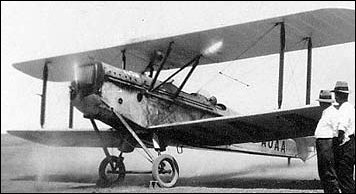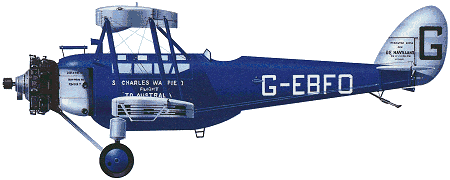 |
De Havilland D.H.501923 |  |
| FOUR-PASSENGER CABIN BIPLANE | Virtual Aircraft Museum / United Kingdom / De Havilland |
 |
Realising in 1922 that war-surplus D.H.9Cs could not be expected to serve much longer, de Havilland used the experience gained in its operation to design a replacement, the de Havilland D.H.50, which carried four passengers in an enclosed cabin between the wings, with the pilot to the rear in an open cockpit. The D.H.9C's Siddeley Puma engine was retained and the result was a reliable and economical light transport. First flown in August 1923, the D.H.50 made an excellent start to its career when, four days later, it was flown by Alan Cobham to compete and win first prize in reliability trials which were being flown daily between Copenhagen and Gothenburg from 7-12 August. Cobham made several long-distance flights with the prototype before using the second aircraft, powered by a 287kW Armstrong Siddeley Jaguar radial engine and redesighated D.H.50J, for a 25,749km flight from Croydon to Cape Town, carried out between 16 November 1925 and 17 February 1926. This was followed later in 1926 by a survey flight to Australia and back, for which twin floats were fitted. A number of orders were placed for D.H.50s, and 16 production aircraft were built by de Havilland. Australian licence production was carried out by QANTAS, which built four D.H.50A and three D.H.50J aircraft; by West Australian Airways, which built three D.H.5OAs; and by the Larkin Aircraft Supply Company, which built a single D.H.50A. European licences were granted to SABCA for construction of three D.H.5OAs at Brussels and to Aero at Prague for seven. The SABCA aircraft were used in the Belgian Congo. Of the total de Havilland production (17 aircraft), only four were based in the UK, two of them with Imperial Airways. One went to the Czech.government, 10 to Australia and one to New Zealand. The longest survivor was the 15th British production aircraft, delivered in 1928 to the Australian Controller of Civil Aviation and destroyed by enemy action in New Guinea during 1942. A wide variety of engines was used in the D.H.50 family; in addition to those mentioned already there were the 224kW A.D.C. Nimbus, 313kW Bristol Jupiter IV, 336kW Jupiter VI, 384kW Jupiter XI, 336kW Pratt & Whitney Wasp C and, in the Czech-built versions, the 179kW Walter W-4.

|  COMPANY PROFILE | |||||||||||||||||||||||||||||||||||||||||||||||||||||||||
 |

|

